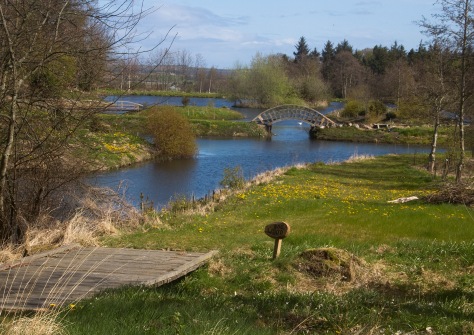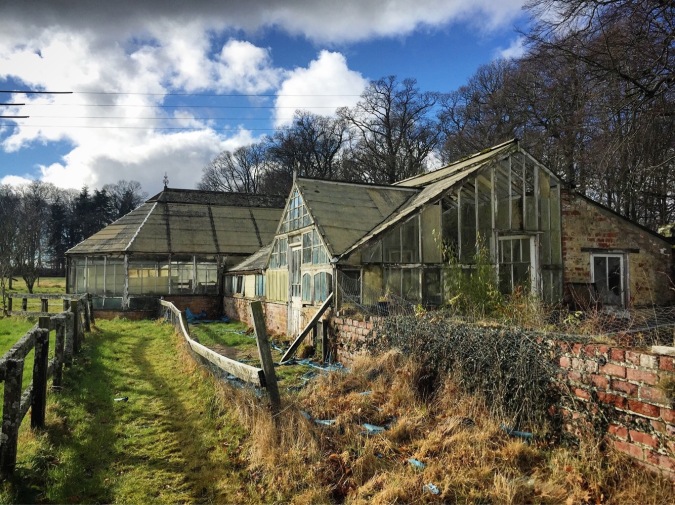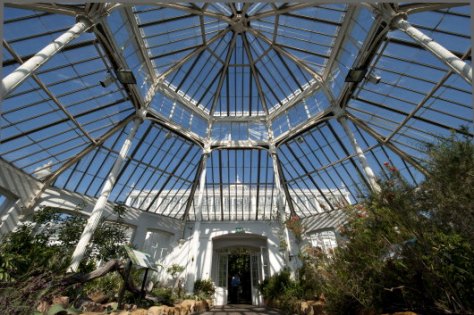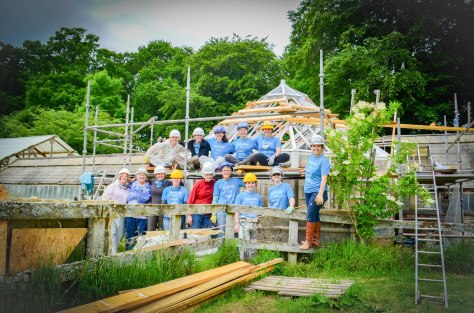Restoring heritage is always about more than just the buildings. While we might get caught up in questions of authenticity, of style and architectural purity and period-accurate method, at the end of the day, I think anyone who preserves heritage does so with the conviction that doing so ultimately makes the world a better place. Even if it’s just in a little tiny way – one building, a doorway, a chimneypiece, a stair-rail – there’s a satisfaction in knowing that you’ve concretely improved one tiny corner in a measurable way. Sometimes its difficult to see just HOW improving heritage improves the world… But then again sometimes it’s really very simple.
At Burgie, Mr. Hamish Lochore is using his historic building to save Scotland’s trees. He’s spent the past 12 years creating an enormous arboretum on his estate, where he grows both endangered Scottish species, as well as exotic species that a huge international network send him from all over the world (legally, of course!). He’s realised that all eight of Scotland’s native surviving species have already been negatively affected by climate change, and are increasingly vulnerable. He’s realised, as many at the Forestry Commission refuse to acknowledge, that the future of Scottish forestry might just require investigating alternative species. Despite the milder microclimate of the Moray coast, tiny seedlings of exotic varieties need a little help in their earliest years before they’re ready to brave the Scottish weather. And this is where the “so what” of the historic greenhouse comes into it.

Hamish has turned his arboretum into a beautiful country park that locals and tourists can visit and enjoy! Swans included 😉
Hamish has done an amazing thing with his ancestral estate. In the grand tradition of country estate owners everywhere, he has moulded and crafted his land into something better than itself. He has made it productive as well as decorative, educational as well as functional – and the same is true for his greenhouse.

Don’t let the dull fibreglass roof deceive you, this glasshouse is a beautiful diamond in the rough!
The glasshouse was originally built in 1912, and it belongs to a world that no longer exists. The social structures of Edwardian Britain eroded after the First World War, and the rural economy and lifestyle changed forever. The glasshouse was built for a household that was designed not just to function, but to impress, with a staff of household servants as well as landscapers and gardeners to keep things running inside and out. The Burgie glasshouse speaks eloquently to this division between those who serve and those who are served; it has separate entrances for staff and visitors, as well as extensive sheds “behind the scenes” that are plainer and clearly meant for the dirtier staging-work of the paid gardeners. And one can just picture the wee coal-monkeys who were sent down into the lowered boiler-room to keep the water-pipes heated. Meanwhile, family members or meticulously-dressed visitors could come in from the walled garden to a gleaming fantasy of crisp, white timber, translucent glass, and of course a well-maintained riot of exotic plants and flowers.While this might not be every person’s ideal, with great divisions in wealth and privilege, it cannot be denied that such divisions wrought beautiful objects, buildings included. But the world has moved on, and the societal structure and purpose that appreciated greenhouses as status symbols and works of art no longer exists. And, like most buildings nowadays, century-old greenhouses are finding that they too must earn their keep to survive.

Historic glasshouses can be positively stunning. Although it’s hard to picture Burgie looking this grand, it once really did, and it could again!
How fortunate then that Hamish’s interests find more than enough uses for his broken-down old greenhouse! Hamish values his land and his heritage. As he said himself, “Who are we if we don’t leave things better than we found them?” But at the end of the day, he needs a working greenhouse for his eco-conservation work; whether it’s historic is in some respects neither here nor there. If he’s got one already on-hand, all the better! But in the state that it’s in… the Burgie greenhouse can’t exactly be said to be “working.” Most of the glass in the roof has fallen out over the centuries, and just to keep the water out Hamish put up some fibreglass sheeting. It keeps the inside relatively dry, but the essential function of a greenhouse – the capture and storage of heat and light through glass – is utterly lost. Right now it’s essentially just a glorified shed, and Hamish’s plants are suffering for it: shaded species are fine, but every year he loses dozens of carefully cultivated plants because they simply can’t get enough light and heat.
One of Hamish’s dedicated volunteers also has a love of historic buildings, and she saw the need – and the solution – right away. She reached out for help and enlisted the support of Adventures in Preservation, an American organisation that pair travel and tourism with heritage volunteering and conservation work. In June they brought 18 volunteers from the US and Australia (almost all women, as it happens!), and Hamish ripped the dirty sheeting off, freeing the beautiful wooden skeleton from its fibreglass prison! Over two weeks, the team sanded, chiseled and cleaned the entire wooden frame of the central house, then primed and painted it until it just glowed – literally, so white!

Fifteen beautiful “AstraGals” got the timber frame trim and glowing during AiP’s June session!
More about the amazing things we discovered during our work – and a few unsolved mysteries we uncovered – in a subsequent post.
But for now, Hamish’s beautiful greenhouse is roofless and gaping open to the elements, and Adventures in Preservation and I are working hard to get a group back in the autumn to get a roof on it before the winter weather sets in – a scenario that would be bad for the greenhouse, and bad for Hamish’s trees!
Registration for the September-October session is live, and will involve cutting and laying the glass for the roof! Visit http://adventuresinpreservation.org/upcoming-adventures-old50/glasshouse-conservation-project-reglazing/http://adventuresinpreservation.org/upcoming-adventures-old50/glasshouse-conservation-project-reglazing/ to register!
